Learn About Big Island
Learn About Big Island
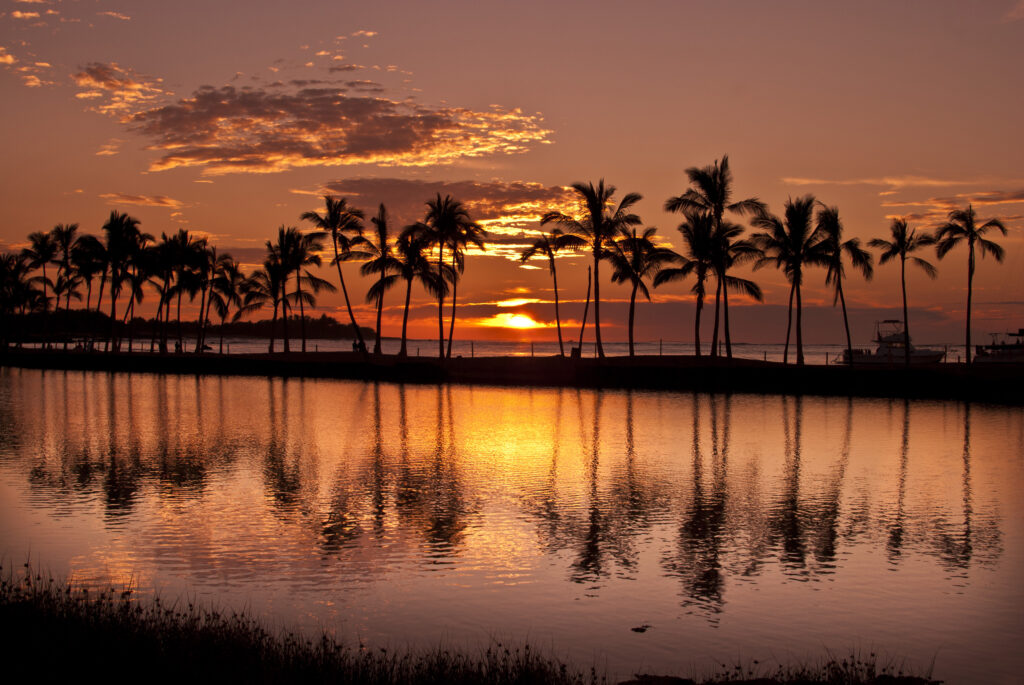
Waikoloa Sunset on the Island of Hawaii in front of ancient fish ponds and coconut tree covered beach.
The Island of Hawaii
The Island of Hawaii, often referred to as "The Big Island," is a land of superlatives and contrasts, where the forces of creation are vividly displayed in its ever-changing landscapes. As the largest of the Hawaiian Islands, it encompasses a diverse tapestry of ecosystems and terrains, from fiery volcanoes and lush rainforests to serene beaches and snow-capped peaks. The Big Island's raw beauty and dynamic geology make it a living laboratory for understanding the processes that shape our planet, while its deep cultural roots and historical significance offer a glimpse into the heart of Hawaiian heritage.
At the core of the Big Island's identity is its volcanic origin, which continues to define the island's landscape and life. The island was formed by five massive shield volcanoes: Kohala, Mauna Kea, Hualalai, Mauna Loa, and Kilauea. While Kohala is now extinct and Mauna Kea is dormant, Mauna Loa and Kilauea remain active, shaping the island with their lava flows and eruptions. Mauna Loa, the largest volcano on Earth by volume, rises 13,679 feet from its base on the ocean floor to its summit, making it a geological giant that dwarfs Everest when measured from its base. Kilauea, one of the world's most active volcanoes, offers a dramatic window into the earth's fiery interior, with its frequent eruptions and molten lava shaping new landforms and renewing the landscape.
Hawaiian mythology holds that the goddess Pele, the deity of volcanoes and fire, resides in Kilauea's fiery depths. Her presence is deeply woven into the island's cultural fabric, symbolizing creation, destruction, and renewal. Visitors to the island often feel a profound connection to Pele's spirit when standing at the edge of Halemaʻumaʻu Crater, gazing into the smoldering caldera that embodies the primal forces of nature.
Beyond its volcanic legacy, the Big Island boasts an unparalleled diversity of ecosystems, earning it the nickname "Island of Aloha" for its ability to host nearly all of the Earth's climate zones. Within a single day, one can journey from the arid lava fields of the Kona coast to the verdant rainforests of Hilo, ascend to the chilly heights of Mauna Kea's summit, and relax on the sun-drenched sands of Hapuna Beach. This diversity supports an incredible array of flora and fauna, including species found nowhere else on the planet, such as the nēnē (Hawaiian goose) and the ʻōhiʻa lehua tree, whose blossoms are said to be Pele's favorites.
The Big Island's human history is equally rich and layered. Polynesian voyagers, guided by the stars and ocean swells, arrived on the island over a thousand years ago, bringing with them plants, animals, and cultural traditions that would become the foundation of Hawaiian society. The Big Island's fertile lands and abundant resources supported thriving communities, and it became the seat of power for King Kamehameha I, who was born in Kohala and rose to unify the Hawaiian Islands into a single kingdom. The Puʻukoholā Heiau, a sacred temple built by Kamehameha in honor of the war god Kū, stands as a testament to his leadership and the island's pivotal role in Hawaiian history.
In the centuries following Western contact, the Big Island became a center of trade and agriculture, with sugarcane plantations dominating its economy in the 19th and early 20th centuries. Immigrant laborers from China, Japan, Portugal, and the Philippines arrived to work on these plantations, contributing to the island's multicultural fabric. This legacy is reflected today in the island's festivals, arts, and traditions that define modern-day island life.
The island's cultural richness is matched by its commitment to preserving its heritage and natural wonders. The Hawaii Volcanoes National Park, a UNESCO World Heritage Site, protects vast expanses of volcanic landscapes, native forests, and archaeological sites. The park offers a unique opportunity to witness geological processes in action while learning about the deep connections between the land and Hawaiian culture. Meanwhile, the Mauna Kea Observatories, perched atop the island's highest peak, serve as a bridge between ancient celestial navigation and modern scientific discovery, making the Big Island a place where past and future converge.
The Big Island is also a land of contrasts in its communities and lifestyles. The sunny Kona coast is known for its world-class resorts, coffee farms, and snorkeling spots, while the rainy Hilo side offers a more laid-back vibe, with botanical gardens, waterfalls, and a strong connection to Hawaiian traditions. Small towns like Waimea, Pahoa, and Hawi each have their own unique character, offering a glimpse into the island's diverse and dynamic spirit.
From the rugged beauty of the Kohala coast to the fertile fields of Hamakua, from the fiery glow of Kilauea's lava to the starlit skies above Mauna Kea, the Big Island is a place of discovery, transformation, and connection. It invites all who visit to embrace its ever-changing landscapes, delve into its rich history, and feel the profound beauty that emanates from its volcanic core. The Big Island is more than a destination; it is an experience that stays with you long after you've left its shores.
History of the Island of Hawaii
The Island of Hawaii, often referred to as "The Big Island," is a land of immense historical and cultural significance. It is the birthplace of the Hawaiian Islands, both geologically and historically, and its story reflects the dynamic forces of nature and human resilience. The island's history is a rich tapestry woven from the strands of its volcanic origins, early Polynesian settlement, the rise of the Hawaiian Kingdom, and its modern evolution as a hub of culture, tourism, and innovation.
Geological Beginnings
The Big Island is the youngest in the Hawaiian archipelago, yet it is also the largest, encompassing an area larger than all the other Hawaiian Islands combined. Its formation began over a million years ago with volcanic activity on the Pacific Plate. The island owes its existence to five massive shield volcanoes: Kohala, Mauna Kea, Hualalai, Mauna Loa, and Kilauea. While Kohala is now extinct, and Mauna Kea dormant, Mauna Loa and Kilauea remain active, continuing to shape the island's landscapes with their frequent eruptions.
Mauna Loa, the largest volcano on Earth by volume, has erupted more than 30 times in recorded history, while Kilauea's nearly continuous activity from 1983 to 2018 captured the world's attention. These eruptions not only create new land but also symbolize the dynamic and ever-evolving nature of the island. Hawaiian mythology attributes the volcanic activity to Pele, the goddess of fire and volcanoes, who is believed to reside in the Halemaʻumaʻu Crater at Kilauea's summit. Pele's presence is a central figure in the island's cultural identity, embodying both creation and destruction.
Early Polynesian Settlement
The Big Island holds a pivotal place in the history of the Hawaiian Kingdom. It was here that King Kamehameha I, born in North Kohala in 1758, rose to power and unified the Hawaiian Islands under his rule. Kamehameha's rise began with his consolidation of power on the Big Island, a process marked by strategic alliances, battles, and his reputation as a skilled and determined leader.
The decisive moment in Kamehameha's unification campaign came in 1795 during the Battle of Nuʻuanu on Oahu, where his forces defeated rival chiefs, solidifying his control over the islands. Kamehameha established the Hawaiian Kingdom in 1810, bringing an era of relative peace and prosperity. The Big Island remained central to his reign, serving as a political and cultural hub. The construction of the Puʻukoholā Heiau in Kawaihae, a massive temple dedicated to the war god Kū, symbolized Kamehameha's authority and the island's significance.
Rise of the Hawaiian Kingdom
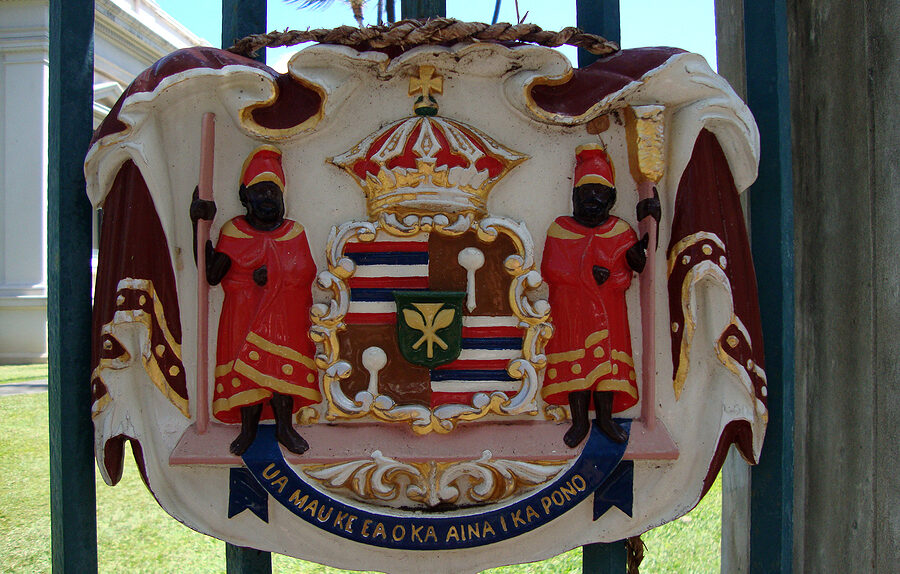
Historic Royal Seal at Iolani Palace one of 16 Bronze Coat of Arms of the government of Hawaii with the state motto: 'Ua Mau Ke Ea o Ka Aina i Ka Pono' (The life of the land is perpetuated in righteousness)
The Big Island holds a pivotal place in the history of the Hawaiian Kingdom. It was here that King Kamehameha I, born in North Kohala in 1758, rose to power and unified the Hawaiian Islands under his rule. Kamehameha's rise began with his consolidation of power on the Big Island, a process marked by strategic alliances, battles, and his reputation as a skilled and determined leader.
The decisive moment in Kamehameha's unification campaign came in 1795 during the Battle of Nuʻuanu on Oahu, where his forces defeated rival chiefs, solidifying his control over the islands. Kamehameha established the Hawaiian Kingdom in 1810, bringing an era of relative peace and prosperity. The Big Island remained central to his reign, serving as a political and cultural hub. The construction of the Puʻukoholā Heiau in Kawaihae, a massive temple dedicated to the war god Kū, symbolized Kamehameha's authority and the island's significance.
Hawaii's Annexation and Statehood
The late 19th century was a time of political turbulence for Hawaii, culminating in the overthrow of the Hawaiian monarchy in 1893. The annexation of Hawaii by the United States in 1898 marked the end of the Hawaiian Kingdom and the beginning of a new chapter in the Big Island's history. As a U.S. territory, the island became more connected to global trade and industry, with significant investments in agriculture and infrastructure.
The 20th century saw the rise of tourism as a major economic driver for the Big Island. The island's natural beauty, cultural heritage, and unique geological features attracted visitors from around the world. Developments such as the construction of resorts along the Kona coast and the establishment of Hawaii Volcanoes National Park in 1916 showcased the island's appeal as a destination for adventure and exploration.
In 1959, Hawaii became the 50th state of the United States, ushering in a new era of modernization and economic growth. The Big Island's population and infrastructure expanded, with efforts to balance development with the preservation of its natural and cultural resources.
Modern-Day Big Island
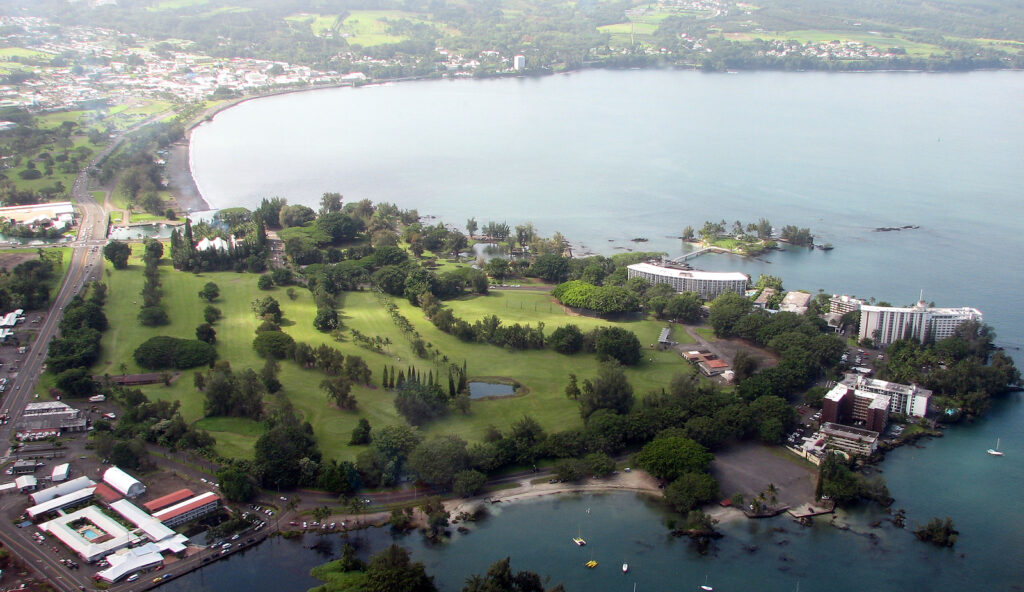
An aerial photo of Hilo Hawaii showing the sea-side resorts.
Today, the Big Island is a vibrant and diverse destination that reflects its rich history and dynamic geology. Hawaii Volcanoes National Park, a UNESCO World Heritage Site, continues to draw visitors eager to witness the island's volcanic activity and learn about its cultural significance. The park's vast landscapes, from the steaming vents of Kilauea to the lava fields of Mauna Loa, offer a unique glimpse into the forces that shaped the Hawaiian Islands.
The Big Island's towns and communities, such as Hilo, Kailua-Kona, Waimea, and Pahoa, each have their own distinct character, blending modern amenities with a deep respect for tradition. Cultural festivals, hula competitions, and community events celebrate the island's heritage, while initiatives in conservation and sustainable tourism aim to protect its natural beauty for future generations.
From its volcanic origins and early Polynesian settlers to its role in the unification of Hawaii and its modern evolution, the Big Island's history is a testament to the resilience and adaptability of its people. It stands as a living reminder of the power of nature and the enduring spirit of aloha that defines Hawaii.
Queen Emma

Queen Emma, taken by Brady in Washington, DC, 1865.
Queen Emma, born in 1836, was the granddaughter of John Young, a trusted advisor to King Kamehameha I. Although she is most closely associated with Oahu, Queen Emma spent significant time on the Big Island, where her family had strong connections. Known for her intelligence, compassion, and advocacy, Queen Emma is remembered as a champion of healthcare and education in Hawaii.
Queen Emma's travels to the Big Island included visits to sacred sites and rural communities, where she worked to improve the lives of Native Hawaiians. Her legacy is honored through institutions such as The Queen's Medical Center, which she co-founded, and her influence continues to be celebrated across the islands.
John Young (Olohana)
John Young, also known as Olohana, was a British sailor who became a key advisor to King Kamehameha I. Stranded on the Big Island in 1790, Young integrated into Hawaiian society and played a critical role in Kamehameha's rise to power. His knowledge of Western military tactics and technology helped Kamehameha secure victories that ultimately led to the unification of the islands.
Young's contributions to Hawaiian history are commemorated at the John Young Homestead in Kawaihae, a National Historic Landmark. His descendants, including Queen Emma, have carried on his legacy, further intertwining his story with the history of the Big Island.
John Young (Olohana)
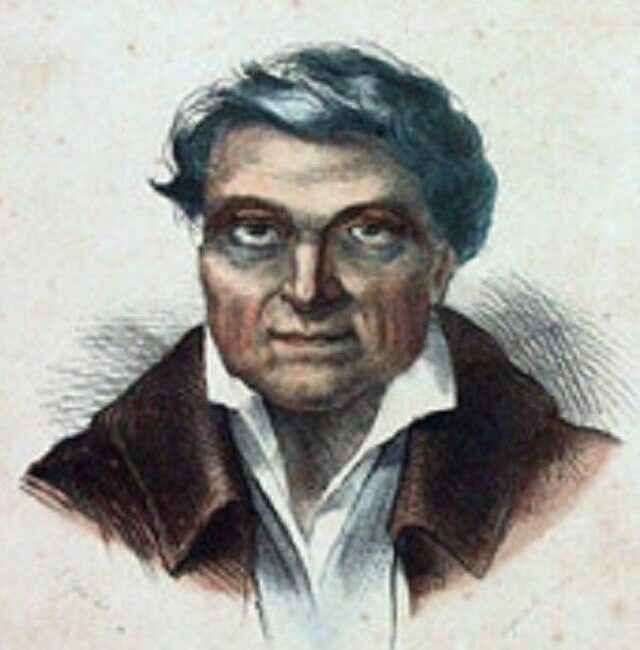
John Young was a British Sailor who became a military advisor to King Kamehameha the Great of Hawaii.
John Young, also known as Olohana, was a British sailor who became a key advisor to King Kamehameha I. Stranded on the Big Island in 1790, Young integrated into Hawaiian society and played a critical role in Kamehameha's rise to power. His knowledge of Western military tactics and technology helped Kamehameha secure victories that ultimately led to the unification of the islands.
Young's contributions to Hawaiian history are commemorated at the John Young Homestead in Kawaihae, a National Historic Landmark. His descendants, including Queen Emma, have carried on his legacy, further intertwining his story with the history of the Big Island.
Senator Daniel Akaka

Senator Daniel Akaka raised in Hawaii
Born in Honolulu, Senator Daniel Akaka had deep roots on the Big Island, where he spent much of his early life and education. Akaka became the first Native Hawaiian to serve in the United States Senate, holding office from 1990 to 2013. Throughout his career, he was a steadfast advocate for Native Hawaiian rights, veterans'affairs, and environmental conservation.
Akaka's work often centered on issues affecting the Big Island, including the preservation of its natural resources and the promotion of education and healthcare for its residents. His legacy lives on through numerous awards and accolades, reflecting his dedication to his community and his commitment to public service.
Prince Jonah Kūhiō Kalanianaʻole
Prince Jonah Kūhiō Kalanianaʻole, born in 1871, was a descendant of Hawaiian royalty and a leader who worked tirelessly to preserve the rights and heritage of Native Hawaiians. Although he was born on Kauai, his efforts greatly impacted the Big Island, particularly through his advocacy for the Hawaiian Homes Commission Act, which provided land for Native Hawaiian homesteading.
Kūhiō's work ensured that Native Hawaiians, including those on the Big Island, could access land and resources to support their communities. His contributions are commemorated annually on Prince Kūhiō Day, and his vision for Hawaiian self-sufficiency continues to inspire generations.
Edith Kanakaʻole
Edith Kanakaʻole, a renowned kumu hula (hula teacher) and cultural practitioner, was born and raised on the Big Island. She dedicated her life to the preservation and perpetuation of Hawaiian language, hula, and cultural practices. Through her halau (hula school), she trained countless students in the art of hula and the values of Hawaiian tradition.
Kanakaʻole's contributions extend beyond hula; she was instrumental in the Hawaiian Renaissance of the 1970s, a cultural revival movement that reawakened pride in Hawaiian identity. Her teachings emphasized the spiritual and environmental connections inherent in Hawaiian culture, and her legacy lives on through the Edith Kanakaʻole Foundation and the annual Merrie Monarch Festival in Hilo.
Israel Kamakawiwoʻole
While Israel Kamakawiwoʻole, also known as Bruddah Iz, was born on Oahu, his connection to the Big Island runs deep through his music and advocacy for Hawaiian culture. His soulful voice and ukulele playing brought Hawaiian music to a global audience, with his rendition of "Somewhere Over the Rainbow/What a Wonderful World" becoming an international sensation.
Bruddah Iz often performed on the Big Island and used his platform to raise awareness about the struggles of Native Hawaiians. His music continues to resonate deeply with the people of Hawaii, embodying the spirit of aloha and the beauty of Hawaiian traditions.
Kumu Hula Nāpua Greig
Nāpua Greig, a respected kumu hula and musician, has deep roots on the Big Island. Her hula teachings and music celebrate the island's landscapes, history, and culture, preserving traditions while inspiring new generations of Hawaiians. Greig's performances and albums have garnered acclaim, earning her recognition as a cultural ambassador for Hawaii.
Her dedication to education and cultural preservation has made her a beloved figure on the Big Island and beyond. Through her work, Greig ensures that the art of hula and Hawaiian music remains vibrant and relevant.
Famous Landmarks and Beaches on the Island of Hawaii
The Island of Hawaii, known as "The Big Island," offers a stunning array of landmarks and beaches that showcase its diverse landscapes and cultural heritage. From towering volcanic craters to pristine shores, the Big Island is a treasure trove of natural wonders and historical sites. Each location tells a unique story, reflecting the island's dynamic geology, rich history, and deep connection to Hawaiian traditions.
Famous Landmarks on the Big Island
Hawaiʻi Volcanoes National Park is one of the most iconic landmarks on the Big Island and a UNESCO World Heritage Site. Spanning over 333,000 acres, the park is home to two of the world's most famous volcanoes: Kilauea and Mauna Loa. Kilauea, one of the most active volcanoes on Earth, has shaped the island's landscape with its frequent eruptions, while Mauna Loa, the largest volcano in the world by volume, rises more than 13,500 feet from its base on the ocean floor to its summit.
Visitors to the park can explore its dramatic volcanic features, including lava tubes, craters, and hardened lava flows. The Halemaʻumaʻu Crater at Kilauea's summit is a sacred site to Native Hawaiians, as it is believed to be the home of Pele, the goddess of fire and volcanoes. The Chain of Craters Road offers breathtaking views of volcanic landscapes, while the Thurston Lava Tube provides a glimpse into the underground world of lava flows.
Mauna Kea Observatories

Observatories on top of Mauna Kea mountain peak. Astronomical research facilities and large telescope observatories located at the summit of Mauna Kea on the Big Island of Hawaii United States
Mauna Kea, the highest peak in Hawaii at 13,796 feet above sea level, is a revered landmark for both its cultural significance and its scientific contributions. In Hawaiian tradition, Mauna Kea is considered sacred, representing a connection between the heavens and the Earth. Its summit is home to some of the world's most advanced astronomical observatories, taking advantage of its clear skies and minimal light pollution.
Visitors can experience Mauna Kea's majesty through stargazing programs at the Onizuka Center for International Astronomy or by hiking to the summit. The mountain's unique environment, which includes snow in the winter months, offers a stark contrast to the tropical landscapes below.
Puʻukoholā Heiau National Historic Site
The Puʻukoholā Heiau is a sacred temple built by King Kamehameha I in 1791 to honor the war god Kū and solidify his quest to unify the Hawaiian Islands. Located in Kawaihae on the island's west coast, this massive stone structure is one of the last major heiau constructed in Hawaii.
Today, the site is a National Historic Landmark, offering visitors a chance to learn about Hawaiian history and Kamehameha's legacy. Interpretive programs and walking trails provide insights into the cultural and spiritual significance of this ancient site.
Waipiʻo Valley

The view from Waipiʻo Valley Lookout on Big Island Hawaii.
Waipiʻo Valley, often called the "Valley of the Kings," is a place of immense natural beauty and historical significance.
Visitors can explore the valley through guided tours or by hiking down the steep road that leads to its floor. The valley's serene atmosphere and dramatic landscapes make it a must-visit destination for those seeking to connect with the island's cultural and natural heritage.
Kealakekua Bay
Kealakekua Bay, located on the Kona coast, is a marine sanctuary renowned for its crystal-clear waters and vibrant coral reefs. The bay is also a site of historical importance, as it was the location of Captain James Cook's arrival in Hawaii in 1779. A monument to Cook stands on the northern shore of the bay, commemorating his interactions with Native Hawaiians and his eventual death.
The bay's calm waters are ideal for snorkeling, kayaking, and diving, offering opportunities to encounter colorful fish, sea turtles, and dolphins. Its combination of natural beauty and historical significance makes Kealakekua Bay a favorite destination for visitors.
Famous Beaches on the Big Island
Hapuna Beach State Park
Hapuna Beach is one of the most celebrated beaches on the Big Island, known for its expansive white sands and turquoise waters. Located on the Kohala Coast, this beach is ideal for swimming, snorkeling, and sunbathing. Its gentle waves make it a family-friendly destination, while its stunning views attract photographers and nature enthusiasts.
During the winter months, Hapuna Beach becomes a prime spot for whale watching, as humpback whales migrate to Hawaiian waters. The beach's amenities, including picnic areas and lifeguards, ensure a comfortable and enjoyable experience for visitors.
Punaluʻu Black Sand Beach
Punaluʻu Black Sand Beach, located on the island's southeastern coast, is a strikingly beautiful beach formed by volcanic activity. The black sand, created by the interaction of lava and seawater, contrasts dramatically with the surrounding greenery and blue ocean.
The beach is a popular resting spot for Hawaiian green sea turtles (honu), offering visitors a chance to observe these gentle creatures in their natural habitat. While swimming can be challenging due to strong currents, Punaluʻu's unique scenery and cultural significance make it a must-visit destination.
Green Sand Beach (Papakōlea)
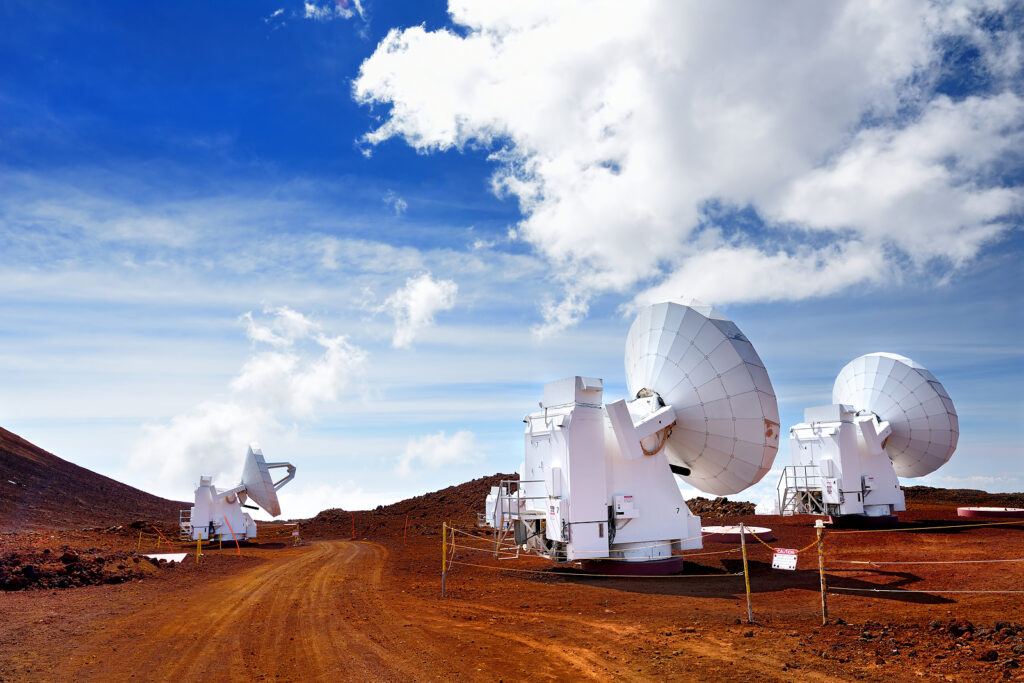
Green Sand Beach, Papakōlea on Big Island, Hawaii, USA.
Papakōlea Beach, also known as Green Sand Beach, is one of only four green sand beaches in the world. Located near South Point, the southernmost tip of the United States, this beach derives its green hue from olivine crystals in the sand, a result of volcanic activity in the area.
Reaching Papakōlea requires a challenging hike or a four-wheel-drive vehicle, but the effort is well worth it. The beach's unique color and secluded setting make it a one-of-a-kind destination that showcases the Big Island's geological diversity.
Kua Bay (Maniniʻowali Beach)
Kua Bay, located within the Kekaha Kai State Park on the island's west coast, is a pristine beach with powdery white sand and turquoise waters. Its calm conditions during the summer months make it perfect for swimming and snorkeling, while winter brings stronger waves suitable for bodyboarding and surfing.
The beach's accessibility and stunning scenery have made it a favorite among locals and visitors alike. As the sun sets, Kua Bay offers spectacular views of the horizon, creating a memorable experience for all who visit.
Richardson Ocean Park
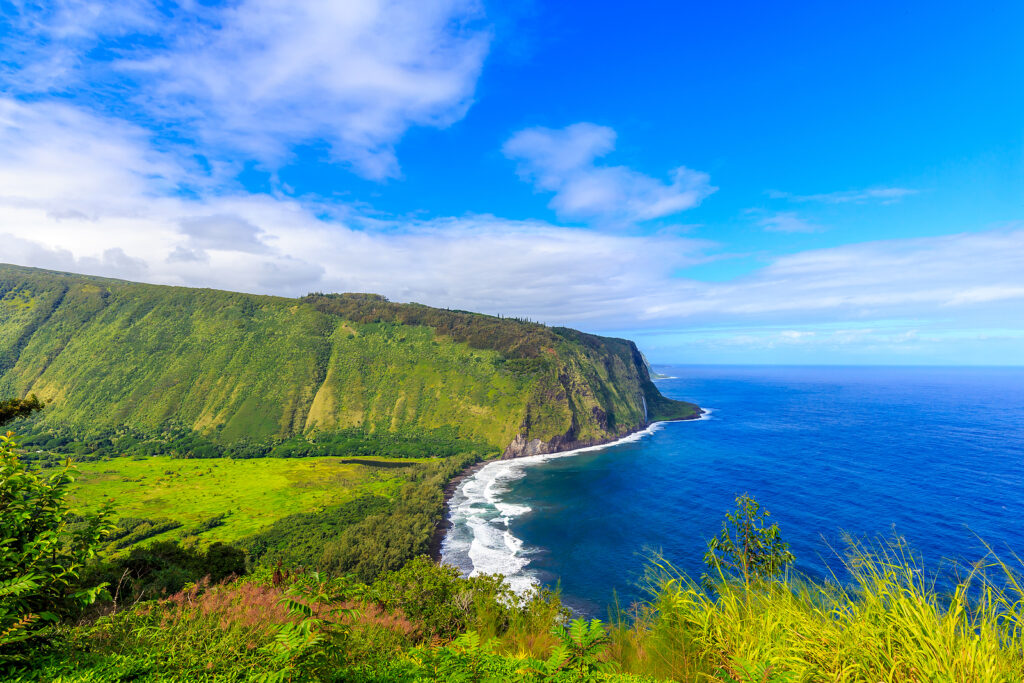
Paradise beach sunset or sunrise with tropical palm trees. Summer travel holidays vacation getaway colorful concept photo from sea ocean water at Big Island, Hawaii, USA.
Located near Hilo on the island's east coast, Richardson Ocean Park is a black sand beach renowned for its vibrant marine life. The park's protected lagoons and coral reefs make it an excellent spot for snorkeling, with opportunities to see colorful fish, sea turtles, and other marine creatures.
Richardson Ocean Park is also a popular destination for picnics and family outings, offering shaded areas, tide pools, and a tranquil atmosphere. Its proximity to Hilo makes it a convenient and rewarding stop for visitors exploring the island's eastern side.
Makalawena Beach

Makalawena beach at Puu Alii Bay Beach, near Kekaha Kai Beach Park, Big Island, Hawaii
Makalawena Beach, located along the Kona coast, is a hidden gem known for its secluded setting and pristine beauty. Accessible only by a hike through lava fields, the beach rewards visitors with soft white sand, clear waters, and a serene atmosphere.
The beach's remote location ensures that it remains uncrowded, making it an ideal spot for relaxation and exploration. Snorkeling, swimming, and sunbathing are popular activities at Makalawena, offering a peaceful escape from more crowded destinations.
The Island of Hawaii's landmarks and beaches are a testament to its natural beauty, cultural richness, and geological diversity. Each site offers a unique experience, inviting visitors to connect with the land and its history while enjoying the unparalleled splendor of the Big Island.